|
|
| It wasn’t until she reached the boarding gate that Darina found out what Kurt had planned. “Sofia? Where would that be now? Hungary? Romania? Armenia?” One of the advantages of surprise holidays is that you don’t have to convince your spouse of the destination’s merits, you just go there! |
|
 |
|
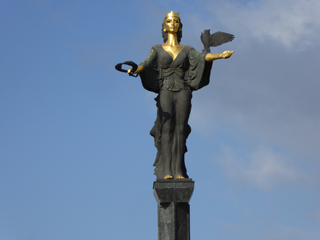 Sofia herself!
Sofia herself! |
Bordering Macedonia, Serbia, Romania, Turkey and Greece, Bulgaria started its transition to democracy with the fall of the Iron Curtain in 1989, joined the EU in 2007 but still has its own currency, the Lev. It’s about three times the size of Switzerland and has a population of 8.5 million. |
|
| Sofia, welcomed us with a heavy downpour and 5° Celsius. Our 12-km spin into town from the airport was more like road rafting and the absence of manhole covers did little to reduce the water flow! The next morning, however, autumn colours adorned the parks in splendid sunshine, while a fresh frosting of snow was visible on Mount Vitosha in the background. |

Ivan Vazov National Theatre |
|
|
 Sofia Synagogue
Sofia Synagogue |

Sofia History Museum |
|
|
 St Alexander Nervsky Cathedral
St Alexander Nervsky Cathedral |
Sofia has enough sights to keep tourists busy for a day or two. Roman ruins, Orthodox churches, mosques and a synagogue as well as stately museums and government buildings are all centrally located downtown. Modern Bulgaria’s first Head of State, Prince Alexander 1 of Battenberg, was laid to rest in a fine Mausoleum there. |
|
|
 President’s Office
President’s Office |

Russian Orthodox Church |
|
|
 Underfloor heating from the Romans
Underfloor heating from the Romans |

Battenberg Mausoleum |
|
|
| It took about half a day in and out of Soviet blocks to exit this city of 1.5 million inhabitants. Then we were on a relatively quiet road following the River Iskar up to an altiplano where shepherds guided their flocks through the plains. |

Suburbs |
|
|
 Fresh snow on Mount Vitosha
Fresh snow on Mount Vitosha |

Along the River Iskar |
|
|

The Iskar Valley |
|
|
 Ride to the Rila monastery
Ride to the Rila monastery |
From there it was down to the Struma River and up a gorgeous side valley to the Rila Monastery. The monastery is seen as the centre of Bulgarian Orthodox culture and is an important place of pilgrimage. The magnificent complex, rebuilt in 1846, houses around 60 monks and attracts about 1 million visitors a year. It has also earned a place on the UNESCO World Heritage list. |
|

Lovely cycling |
|
| The right hand of St Ivan (The Miracleworker), Bulgaria’s first hermit and the country’s patron saint is housed in the monastery. In the sanctum sanctorum pilgrims retrieve wads of cotton wool thought to have miraculous powers because of their proximity to the bones. |

Apocalyptic murals in Rila Monastery |
|
|

Rila Monastery complex |
|
|
 |
After Rila, we followed the Struma towards the Greek border passing vineyards, bee hives, harvested fields and forests, intercepted by a micro-spa experience! |
|
|
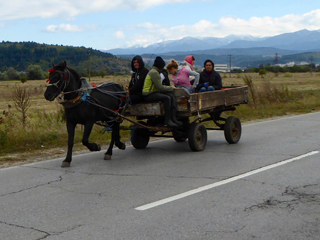
Ponies & traps are a common sight |

Traditional farming |
|

Not a soul in sight! |
|
|
| The roads were of varying quality, but we stuck to the pleasant quiet country roads where possible, thanks to Google maps. Drivers were generous with space when there was any, and there was just a stretch of 17km through the valley where there was no quieter alternative available. |

Quiet country roads |
|
|
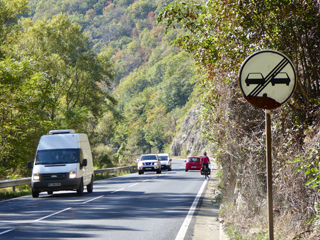 The busy stretch
The busy stretch |

A cyclist’s dream |
|
|
 EU funded roads
EU funded roads |
Many road signs publicised their EU funding and dated back as far as 2002, showing their preparation for EU membership. |
|
|
| The countryside was dotted with statues reminiscent of the Soviet era. We can only guess that they were local heroes back in the days when the lawn in front was regularly mowed! |

One of Bulgaria’s many heroes |
|
|
 Blagoevgrad
Blagoevgrad |

Roadside stall of honey & propolis |
|
|
 Dinner for two
Dinner for two |
In Bulgaria, hungry cyclists have nothing to fear! A main course is designed for two with 400-500g of meat. Starters are generally salads, soups or dips, served with bread/toast. When there was room for dessert, it was a sweet cake or yoghurt with nuts and honey. We never paid more than 40 Leva (20€) for a three-course meal for two with drinks included. |
|
|
 Konrad beer for Kurt
Konrad beer for Kurt |

Tricycle wine is all the go! |
|
|
| Bed and breakfast for two generally came to another 40 Leva (20€) and breakfast ranged from omelets to stuffed pancakes with coffee/tea. |

A cheerful start to the day! |
|
|
 Cyrillic script
Cyrillic script |
 Borovets ski resort |
|
|
 Friendly folk at Alex’s in Samolov
Friendly folk at Alex’s in Samolov |
We found the Bulgarians quietly reserved but very helpful and accommodating. Language was a barrier for in-depth political debates, but our dobro utro, dober den, tschau and merci brought us a long way! Most had a smattering of English and some boasted fluent German from school. |
|
|
 Getting directions in Blagoevgrad
Getting directions in Blagoevgrad |

Presents of grapes in Kresna |
|
|
| The nearest border into Greece is on a motorway, with no bicycle access. When the bus we hoped to take didn’t turn up, the locals organized a taxi that shuttled us to the next Greek town for a few euros. Nothing was a problem! |

Taxi to Greece |
|
|
 Bulgarian flag
Bulgarian flag |
Our short stint in Bulgaria gave us a taste for this hospitable country, which we can highly recommend as a cycling destination. We’ll be back! |
|
|
 |
|
|
| This part of the world has long been on Kurt’s mind, and was therefore also responsible for the Bulgarian extension of this surprise trip. |

Northern Greece |
|
|
 Ouzo tidbits for 9€
Ouzo tidbits for 9€ |
Serres was lively and full of people milling around and having a good time. The hotel owner explained that as a university town, eating out is not only available 24/7, it is also possible on a tight student’s budget. We spent a little bit more and came away bulging. Some things never change! |
|
|
| The next day, we were blown through a huge plain of cotton fields. Cotton amounts to 8% of Greek’s agricultural output, and 80% of Europe’s cotton is grown there. The tail wind was cool for us, but not great for the local farmers, as the hedgerows were full of stray cotton. It would make sense to erect a Belfast Peace Wall at the end of the valley to aid harvesting! Considering the area is only a few days cycling from St. Ivan’s bones, the cotton might even work miracles! |

Cotton fields |
|
|
 And now for the coast..
And now for the coast.. |
After crossing a minor mountain range to the old Via Egnacia, we reached the Aegean Sea at Stavros. From then on it was a genuine holiday. Climbs provided viewpoints, while downhills offered deserted beaches. The water was still warm enough for a swim and the sun dried us quickly without a roasting effect. |
|
|
 |
 |
|
Off-season on Kalamitsi beach |
|
|
| The tourist season is definitely over in October. Accommodation should be sought in villages with a resident population to ensure an open tavern for the evening dinner, with a spot of people watching thrown in for good measure. And, you’ll have all the felines from the area fighting for your undivided attention in the hope of a scratch and a morsel. Bed and breakfast for two generally came to 40€, dinner with drinks about 30€. |

A room with a view in Pirgadikia |
|
 Feta/custard pie for breakfast
Feta/custard pie for breakfast |

Grilled squid for dinner |
|
|
 |
 |
|
There is a two-year waiting list to have a boat built in Ierissos. |
|
|

Karidi beach, Vourvourou |
|
|
| We did a loop of the stunning Sithonia peninsula, marvelling at the turquoise waters and white-sand beaches. It looked just like the Caribbean. Google maps helped us follow the coast, with road quality varying from strand promenades to gravel tracks hugging the most beautiful secluded coastline imaginable. |
|
|
 |
|
|
|

Paradise
found in Stili tou Dios Bay |
|
|
 The powers of erosion
The powers of erosion |

Pomegranate season |
|
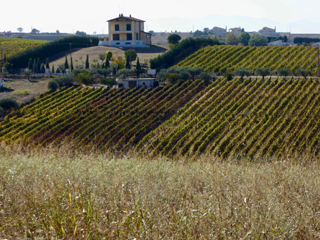 Vineyards above Perea
Vineyards above Perea |

Bee hives with view of Mt Athos |
|
|
 Orthodox church in Nea Moudania
Orthodox church in Nea Moudania |

Amazing sunsets in Sithonia |
|
|
 Perea
Perea |
Our last stop was Perea, on the beach opposite Thessaloniki, just 10km from the airport. We had a day to explore this unheralded city before flying home. From the landmark white tower to the medieval city wall, there are many remnants from pre-Roman times on. |
|
|
 The old city wall
The old city wall |

The White Tower |
|
|
|
The area came to prominence with their most famous son: Alexander the Great. Marching all the way to the Indus river in today’s Pakistan, he conquered half the known world at the time (330BC). He died in Babylon leaving behind an empire too big for any of his generals to rule. |

Alexander, the Great |
|
|
 Rotonda: Temple of Zeus (306AD)
Rotonda: Temple of Zeus (306AD) |
Thessaloniki rose to some importance again some 300 years later under Roman rule, with its important location on the famous Via Egnatia connecting Albania’s Durres with Constantinople. |
|
|
| The charming neighbourhood of Áno Póli consists of fine old houses built in Turkish fashion. Numerous hidden plazas with taverns and cafés make Thessaloniki a pleasant place to start or end a trip in the region. |

Áno Póli |
|
|
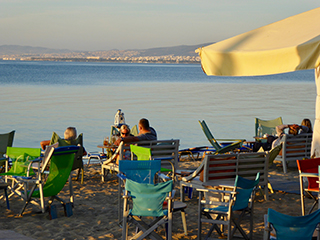 Friendly Greeks all round.
Friendly Greeks all round. |
The friendliness of the Greeks was comparable to their northerly neighbours. However, we did find the Greeks a lot more extroverted and animated than the Bulgarians. Could it be a question of tourist exposure or rather the Mediterranean culture versus the quieter Slavic way of life? |
|
| This wonderful trip was a big surprise (not only for Darina), and we both came to the conclusion that a few months on the side roads in Bulgaria and Greece would be time well spent. Kurt is making mental notes for retirement! |

Greek and Macedonia area flags |


